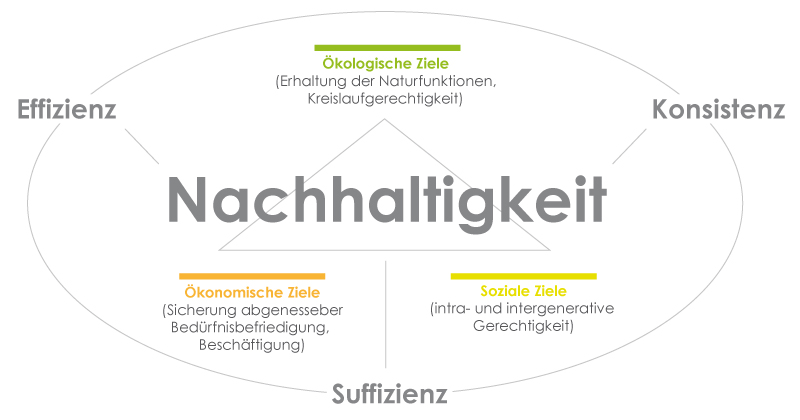What does “sustainability“ mean?
Sustainability means the shaping of a system in such a way that it can permanently persist. The most widespread definition of sustainaibility was formulated in 1987 by the so-called Brundtland Commission: “Sustainable development is a development, which satisfies the needs of the present generation, without restricting the possibility of generations to come to satisfy their own needs and choose their lifestyle.” (Brundtland Report, 1987).
The UN Commission emphasizes in this definition intra- and intergenerational justice, which adheres to the concept of sustainability: On the one hand the distribution between presently living generations as a balance between the people, mainly related to the distribution between global North and global South. On the other, the balance between presently living and future generations, i.e. the obligation to stand for the conservation of the environment and the stability of society on behalf of the children and the children’s children.
“Using resources so that they can be replaced”
The contemplation of the word „sustainability” and its interpretation in various languages yields interesting results: “Sustainability” in German means in its proper sense something like”using resources, so that they can be replaced”, whilst in other languages, for instance in French or Slovenian, “permanence” or “capacity” have a stronger emphasis. The English term of „sustainability“ finally means „to support from the bottom” or “to maintain development”.
The history of sustainability
Already at the beginning of the 18th century, the idea of sustainability was for the first time formulated relative to forestry. Hans Carl von Carlowitz wrote in 1713 about a “sustainable use” of forests, which shall in the long run only be chopped to the extent, which can grow again.
The term, however, only receives broader popularity and political attention at the dawn of the environmental movement in the 1970ies, which subsequently led to the installation of environmental ministries in Europe (e.g. since 1971 in Austria), and to the foundation of large environmental NGOs (e.g. Global 2000 in August 1982). In 1972, the first UN Conference on the Human Environment was held in Stockholm, in 1992 the quite successful “UN Conference on Environment and Development” in Rio de Janeiro.
In Europe, in 2001 in Goeteborg the European Strategy for Sustainable Development was passed, which was revised in 2006. Austria has had its own sustainability strategy since 2002.

The three dimensions of sustainability
Sustainability is shown on three levels: in the ecological dimension (environment), in the economic dimension (economy), and in the social dimension (society). Frequently, sustainability is represented in a three-column chart. This chart, however, suggests that the three columns are distinct spheres, which usually does not apply in reality. The “triangle of sustainability“ solves this problem, because it becomes clear that the dimensions of sustainability are connected to one another.
Sometimes the scientific discourse also mentions a fourth dimension of sustainability, which is partially designated as “culture”, partially as an institutional dimension within the meaning of governance and political control systems.
What does sustainability mean?: 21.Nov.2012 Teilen
Tweet
![]()










